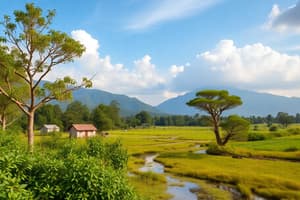Podcast
Questions and Answers
What primarily affects the duration and intensity of sunlight reaching a region's surface?
What primarily affects the duration and intensity of sunlight reaching a region's surface?
- Ocean currents
- Latitude (correct)
- Wind speed
- Precipitation patterns
How does climate influence biodiversity in a region?
How does climate influence biodiversity in a region?
- Climate affects the availability of resources like water and nutrients. (correct)
- Climate determines the size of animal populations only.
- Climate influences only plant types and not animal groups.
- Climate has no impact on biodiversity.
Which of the following is NOT a factor that affects climate?
Which of the following is NOT a factor that affects climate?
- Soil composition (correct)
- Latitude
- Elevation
- Proximity to water
What is characteristic of regions classified as in the 'Tropic (Hot)' zone?
What is characteristic of regions classified as in the 'Tropic (Hot)' zone?
Which of these statements about the relationship between climate and geographic factors is true?
Which of these statements about the relationship between climate and geographic factors is true?
Which climatic zone is characterized by severe winters and very short days in winter?
Which climatic zone is characterized by severe winters and very short days in winter?
In which latitude range does the Tropic climatic zone lie?
In which latitude range does the Tropic climatic zone lie?
What type of precipitation is predominantly found in the Arctic zone?
What type of precipitation is predominantly found in the Arctic zone?
Which climatic zone experiences significant variations in temperature throughout the year?
Which climatic zone experiences significant variations in temperature throughout the year?
What phenomenon is referred to as the 'Land of the Midnight Sun'?
What phenomenon is referred to as the 'Land of the Midnight Sun'?
Which factor contributes to stronger winds as the pressure difference increases?
Which factor contributes to stronger winds as the pressure difference increases?
How does the Coriolis effect influence wind in the atmosphere?
How does the Coriolis effect influence wind in the atmosphere?
What occurs when the pressure gradient force and the Coriolis force balance in the atmosphere?
What occurs when the pressure gradient force and the Coriolis force balance in the atmosphere?
Which of the following best describes the prevailing wind?
Which of the following best describes the prevailing wind?
What did Alexander von Humboldt contribute to the understanding of elevation and climate?
What did Alexander von Humboldt contribute to the understanding of elevation and climate?
C. Hart Merriam's research involved classifying the Colorado Plateau based on what factor?
C. Hart Merriam's research involved classifying the Colorado Plateau based on what factor?
In the context of climate regions, what is the primary characteristic of arctic zones indicated in the elevation diagram?
In the context of climate regions, what is the primary characteristic of arctic zones indicated in the elevation diagram?
How does topography influence climate according to prevailing wind patterns?
How does topography influence climate according to prevailing wind patterns?
What is the expected temperature decrease as altitude increases by 200 meters?
What is the expected temperature decrease as altitude increases by 200 meters?
How does relief, specifically mountains, affect precipitation?
How does relief, specifically mountains, affect precipitation?
What defines a south-facing slope in terms of temperature exposure?
What defines a south-facing slope in terms of temperature exposure?
What is the primary characteristic of heat sinks, such as large bodies of water?
What is the primary characteristic of heat sinks, such as large bodies of water?
Which lapse rate applies to the cooling of air as it rises up a mountain slope?
Which lapse rate applies to the cooling of air as it rises up a mountain slope?
How does proximity to water affect temperature variability in coastal areas?
How does proximity to water affect temperature variability in coastal areas?
What is thermal inertia related to in climate context?
What is thermal inertia related to in climate context?
What effect does descending air have on its moisture-holding capacity?
What effect does descending air have on its moisture-holding capacity?
What is the primary reason for the creation of sea breezes during the daytime?
What is the primary reason for the creation of sea breezes during the daytime?
Which statement best describes thermal inertia?
Which statement best describes thermal inertia?
What happens to the air above land during nighttime compared to the air above water?
What happens to the air above land during nighttime compared to the air above water?
The uneven heating of the Earth's surface primarily leads to which of the following phenomena?
The uneven heating of the Earth's surface primarily leads to which of the following phenomena?
Which best describes the specific heat capacity of water in comparison to land?
Which best describes the specific heat capacity of water in comparison to land?
What effect does the denser air over land have during the night?
What effect does the denser air over land have during the night?
What role do convective currents play in the environment?
What role do convective currents play in the environment?
Which factor does NOT typically influence the climatic conditions of a country?
Which factor does NOT typically influence the climatic conditions of a country?
Which factor has the most influence on thermohaline circulation in the ocean?
Which factor has the most influence on thermohaline circulation in the ocean?
What primarily drives wind-driven circulation in the ocean?
What primarily drives wind-driven circulation in the ocean?
What is the primary result of ocean water becoming denser?
What is the primary result of ocean water becoming denser?
Which ocean currents connect into a global ocean system?
Which ocean currents connect into a global ocean system?
How does elevation notably impact regional climate according to Humboldt's research?
How does elevation notably impact regional climate according to Humboldt's research?
Which statement about the Coriolis effect is true?
Which statement about the Coriolis effect is true?
What significant climatic event was influenced by the southward shift of ocean currents?
What significant climatic event was influenced by the southward shift of ocean currents?
Which process does not contribute to ocean water density changes?
Which process does not contribute to ocean water density changes?
Flashcards
Climate
Climate
Long-term weather trends in a region, averaged over 30 years.
Latitude
Latitude
Geographic coordinate indicating north-south position, from 0° at the equator to 90° at the poles.
Factors Affecting Climate
Factors Affecting Climate
Includes latitude, ocean current, wind, elevation, relief, and proximity to water.
Tropic Zone
Tropic Zone
Signup and view all the flashcards
Temperate Zone
Temperate Zone
Signup and view all the flashcards
Arctic Zone
Arctic Zone
Signup and view all the flashcards
Land of the Midnight Sun
Land of the Midnight Sun
Signup and view all the flashcards
Effect of Latitude on Climate
Effect of Latitude on Climate
Signup and view all the flashcards
Air Pressure Gradient
Air Pressure Gradient
Signup and view all the flashcards
Coriolis Effect
Coriolis Effect
Signup and view all the flashcards
Geostrophic Wind
Geostrophic Wind
Signup and view all the flashcards
Prevailing Wind
Prevailing Wind
Signup and view all the flashcards
Effect of Elevation on Climate
Effect of Elevation on Climate
Signup and view all the flashcards
Life Zones by Elevation
Life Zones by Elevation
Signup and view all the flashcards
Temperature and Dryness Relationship
Temperature and Dryness Relationship
Signup and view all the flashcards
Regional Characteristics
Regional Characteristics
Signup and view all the flashcards
Temperature decrease rate
Temperature decrease rate
Signup and view all the flashcards
Relief in climate
Relief in climate
Signup and view all the flashcards
Mountains and precipitation
Mountains and precipitation
Signup and view all the flashcards
Adiabatic lapse rate
Adiabatic lapse rate
Signup and view all the flashcards
Saturated adiabatic lapse rate (SALR)
Saturated adiabatic lapse rate (SALR)
Signup and view all the flashcards
Proximity to water
Proximity to water
Signup and view all the flashcards
Thermal inertia
Thermal inertia
Signup and view all the flashcards
Ocean Currents
Ocean Currents
Signup and view all the flashcards
Wind-driven circulation
Wind-driven circulation
Signup and view all the flashcards
Thermohaline circulation
Thermohaline circulation
Signup and view all the flashcards
Global Ocean Conveyor
Global Ocean Conveyor
Signup and view all the flashcards
Density differences
Density differences
Signup and view all the flashcards
Elevation impact
Elevation impact
Signup and view all the flashcards
Humboldt current
Humboldt current
Signup and view all the flashcards
Specific Heat Capacity
Specific Heat Capacity
Signup and view all the flashcards
Convective Currents
Convective Currents
Signup and view all the flashcards
Sea Breeze
Sea Breeze
Signup and view all the flashcards
Land Breeze
Land Breeze
Signup and view all the flashcards
Uneven Heating
Uneven Heating
Signup and view all the flashcards
Daytime Heating Effect
Daytime Heating Effect
Signup and view all the flashcards
Nighttime Cooling Effect
Nighttime Cooling Effect
Signup and view all the flashcards




